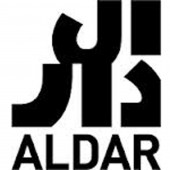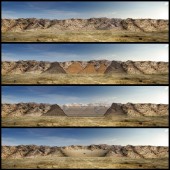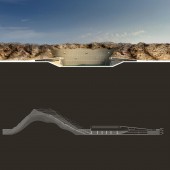DESIGN NAME:
The Rock Stadium
PRIMARY FUNCTION:
Sports stadium
INSPIRATION:
The initial brief was to design a stand-alone football stadium for 40,000 spectators, in the Al Ain desert. However, when the architects visited the site of Jebel Hafeet where the stadium was intended to be built and assessed the geology and positioning of the site, the steep mountain, its slopes and its orientation instantly reminded them of the classic Greek amphitheatre setting.
That’s how the idea of carving into the mountain came to light, similarly to the Greek amphitheater which worked with the topographic landscape of its site, and was generally carved out of the side of a hill, taking advantage of sloping hillsides for its terraced seating.
The architects were so inspired by the site that they were led to intricately work with it, and instead of proposing to build the stadium next to the rocky hillside, they decided to build it within the existing geographical features, challenging the site to new measures by sculpting it, refining its elements and playing with the mass and void relationship.
The proposed grand entrance of the stadium into the underground creates a monumental approach to the space of events, similar to the imposing entrance of the Temple of Anahita (Iran).
UNIQUE PROPERTIES / PROJECT DESCRIPTION:
Set in the Al Ain desert landscape, the Rock Stadium celebrates the game it hosts as much as it celebrates the site in which it lays.
Recognizing the powerful language of its surrounding and intelligently approaching the issue of scale and the intermittent use of the stadium architecture, the project sinks its 200,000m² structure into the ground and turns the Jebel Hafeet rocky mountain into one of its main features.
Inspired by the first greek amphitheatre, the project creatively works with the topography and relies on a series of emerging planes to mold the space and help cater for the 40,000 seats which it provides. Its grand entrance into the underground creates a monumental approach to the space of events, similar to the imposing entrance of the Temple of Anahita.
Issues of scale, timing and activity were highly investigated by the architects and by forcing the stadium into the ground, the designers were strategically able to deal with the challenging issue of massiveness of scale and of the often voided space. The project not only gracefully blends itself into its surrounding but plays on the notion of distance to alternate between a strong camouflage at distance and a forceful presence at close range. A sculpted landscape or a defined void, the project becomes a jewel in the desert which lights up at night allowing the active evenings to turn the stadium into a massive light beam that emerges from the ground straight to the higher sky and creates a symbol, a sign, a guiding agent to the national event and place of activity in an otherwise sign-less desert environment.
Working with the existing site and using the local materials, the architects find themselves playing with a carefully studied palette of rock and sand that not only lead to the main façade/visual panels system adhering to the site but also create a more sustainable approach to construction and design where no material is forgotten or displaced and where all is reused.
Careful patterns are created with the recuperated stone, creating interestingly designed man-made strata patterns that emphasize the natural characteristic of the site.
Maximizing the use of on-site material, the visionary design of the Rock Stadium merges landscape and architecture, thus blurring the boundaries between the built and the natural and creating a space that allows the visitor to interact with the stadium activities as much as with the desert landscape itself.
This simple yet majestic design hides great achievements and brilliant experimentations with issues of scale, monumentality and locality, hence allowing the project to create a strong sense of place in an otherwise homogenous area of the vast expanding desert.
OPERATION / FLOW / INTERACTION:
-
PROJECT DURATION AND LOCATION:
This project is still at design stage, without any estimated date of construction.
Location: Al Ain, United Arab Emirates
FITS BEST INTO CATEGORY:
Architecture, Building and Structure Design
|
PRODUCTION / REALIZATION TECHNOLOGY:
MZ Architects believes in marrying environmental sustainability to creative design. In the case of the Rock Stadium, the materials proposed to be used for construction are the main sustainable feature of the project. When carving the tiers into the rocks, the architects suggest to recuperate the extracted stone and crash it to obtain a reusable building material. Mixed with adhesive, this material is remolded into man-made strata patterns that will shape the main tiers of the stadium.
Moreover, the stadium features three platform-shaped concrete roofs which are to be covered with excavated sand, thus emphasizing the natural characteristic of the site and allowing the stadium to blend into its surrounding landscape.
Through this sustainable approach to construction and design, no material is forgotten or displaced and all is reused.
SPECIFICATIONS / TECHNICAL PROPERTIES:
Plot area: 563,333 sqm
Total built-up area: 206,300 sqm
Total number of spectators: 40,000 (Public: 38,300 - VIP: 600 - VVIP: 100 - Disabled seats: 1,000)
TAGS:
Stadium, Landscape, Sustainable design, Desert, Strata extraction
RESEARCH ABSTRACT:
The Hafeet mountain is a large hill situated south of Al Ain that extends for some 10km and rises to almost 1300m in elevation. While developing the idea for the stadium, MZ Architects formed a team of experts composed of a geologist, a stone specialist, a topographer and a cave expert, and they all headed to Al Ain where they camped for three days to analyze the site. In order to decide upon the ideal location of the stadium within this large site, they looked into a number of criteria, mainly the orientation of the proposed stadium with respect to the sun, the regularity of the mountain, the geology and the stratigraphy of the hills.
CHALLENGE:
The most challenging task was to find a portion of the hills which had a regular elevation & was large enough to fit the size of the main stadium tiers. The Hafeet mountain being deeply incised with summits, wadis and eroded faces, the team was on a mission to explore the mountain until they located an ideal setting where the mountain was made out of five regular folded strata. MZ Architects' proposal is to extract the three strata in the middle to give place to the engraved tiers and keep the remaining strata on the sides as part of the stadium design and aesthetics.
As per the FIFA requirements, a North-South field orientation is often considered ideal to help keep direct sun out of the eyes of players and fans. Knowing that Jebel Hafeet is oriented almost exactly North-South, this primary criteria was naturally met, thus supporting the architects' conviction that the site was perfect for a stadium carved directly into the rocky mountain.
ADDED DATE:
2012-08-02 06:20:52
TEAM MEMBERS (1) :
Architect: MZ Architects
IMAGE CREDITS:
MZ Architects, 2012.
|










